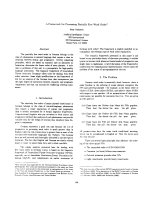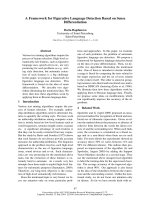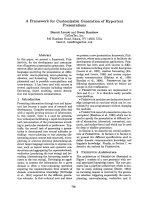A framework for pervasive web content delivery
Bạn đang xem bản rút gọn của tài liệu. Xem và tải ngay bản đầy đủ của tài liệu tại đây (2.23 MB, 358 trang )
A FRAMEWORK FOR PERVASIVE WEB CONTENT DELIVERY
HENRY NOVIANUS PALIT
(S. Kom., ITS, Surabaya; M. Kom., UI, Jakarta)
A THESIS SUBMITTED
FOR THE DEGREE OF DOCTOR OF PHILOSOPHY
DEPARTMENT OF COMPUTER SCIENCE
SCHOOL OF COMPUTING
NATIONAL UNIVERSITY OF SINGAPORE
2006
ii
Acknowledgements
Praise and glory be to the Lord, who has given me strength to pursue my purposes in life,
courage to confront any challenge, perseverance to carry on in the midst of turbulence, and
wisdom to keep me humble. He is my shepherd and my comfort; I shall not be in want.
I would like to take this opportunity to express my utmost gratitude to Prof. Chi
Chi Hung for his inspiration, encouragement, and invaluable advice throughout the course
of my research. Not only is he the best supervisor to guide me in this research field, but
outside of the research work he is also a great mentor, from whom I learn a lot about
important things in life. For the time he made available for research discussions, the effort
he spent on reading and revising my research papers and thesis, the help he offered when
I was in trouble, and the patience he showed against my late progress, I am always
thankful.
I would also like to thank my replacement supervisor, Asst. Prof. Ken Sung Wing
Kin, for allowing me to stay in his laboratory and for assisting me with all the
administrative matters. I am sincerely grateful for his tremendous effort to help my
research keep on as smoothly as possible.
This study would not have been possible without the Research Scholarship I
received from the National University of Singapore. Therefore, I thank the University –
and the School of Computing, in particular – for giving me the opportunity to pursue my
postgraduate study.
iii
Through my many years in Multimedia Information Laboratory, I had worked
with not just colleagues but caring and hospitable friends. I have benefited from many
research discussions with Hongguang, William, Junli, Li Xiang, Su Mu, and Choon Keng
as much as I have enjoyed their warm and sincere friendship. My interaction with other
friends like Meng, Rain Zhang, Akanksha, Wenjie, and Xiao Yan has made my stay there
pleasant and lively.
Moreover, I am indebted to my brothers and sisters in Christ for their support,
prayers, and companionship. In particular, I would like to thank – among others – Eni and
Martin, Henny and Karim, Evelyne and Didi, Aini, and my Cell Group’s and Prayer
Group’s friends. I thank Heng Thong, my flatmate, for the same support, prayers, and
companionship he has given me. An abundance of appreciation and gratitude also goes to
Dina, who kept “jia you”-ing me all the way till the completion of this thesis. I really
hope one day I can repay you the same favor.
Above all, I would like to express my highest appreciation to my parents, sister,
and brother for their endless love, compassion, encouragement, and persistent prayers.
Forever, I owe them an immense debt of gratitude. To them, I dedicate this thesis.
iv
Table of Contents
Acknowledgements ii
Summary x
List of Tables xii
List of Figures xiv
Publications xvii
Chapter 1 Introduction 1
1.1 Overview of Web Content Delivery 2
1.2 Challenges in Web Content Delivery 4
1.3 Efforts to Address the Challenges 6
1.3.1 Content Caching and Replication 6
1.3.2 Intelligent Network 9
1.3.3 Multimedia Standard 11
1.4 Motivation: What Will Be the Future Web Content Delivery? 13
1.4.1 Pervasive or Ubiquitous Service 13
1.4.2 Fine-Grained Entities with Heterogeneous Properties 14
1.4.3 On-Demand Delivery with Efficient Data Reuse 14
1.4.4 Rich Meta-data 15
1.5 Objectives and Contributions 16
1.5.1 Objectives 16
1.5.2 Contributions 17
1.6 Scope and Organization of the Thesis 18
v
Chapter 2 Literature Review 20
2.1 Content Caching and Replication 21
2.1.1 HTTP and Web Caching 21
2.1.2 Content Distribution Network 24
2.1.3 Techniques for Reducing Latency 27
2.1.4 Techniques for Handling Dynamic Contents 29
2.2 Intelligent Network 33
2.2.1 Web Protocol’s Support 34
2.2.2 Transcoding Systems 36
2.2.3 ICAP and OPES 47
2.2.4 Semantic Web 52
2.3 Multimedia Standards 55
2.3.1 JPEG 2000 57
2.3.2 MPEG-4 60
2.4 Concluding Remarks 67
Chapter 3 A Fine-Grained, Scalable Data Model 70
3.1 Background 71
3.2 Concept of Object Decomposition and Construction 73
3.3 Specifications of Data Model 77
3.3.1 Definition 1: Object 77
3.3.2 Definition 2: Segment and Atom 79
3.3.3 Definition 3: Representation 80
3.3.4 Definition 4: Supplement 81
3.3.5 Operation 1: Selection 83
vi
3.3.6 Operation 2: Inverse-Selection 83
3.3.7 Operation 3: Join 84
3.3.8 Operation 4: Translation 85
3.3.9 How Is It Useful? 86
3.4 Modulation – A Scalable Adaptation 87
3.5 Related Work 93
Chapter 4 Modulation in JPEG 2000 96
4.1 Why Use JPEG 2000? 97
4.2 JPEG 2000 Modulators 98
4.2.1 General Issues 99
4.2.2 Modulator 1: JP2Selector 106
4.2.3 Modulator 2: JP2Joiner 115
4.2.4 Modulator 3: JP2Converter 116
4.3 Related Work 119
Chapter 5 Evaluation: Modulation vs. Transcoding 122
5.1 Rationale of Using Two Different Image Standards 123
5.2 Experimental Setup 124
5.2.1 Experimented Adaptors 124
5.2.2 Image Test Data 126
5.3 Generating Image Representations 129
5.3.1 Bit-Rate Performance 131
5.3.2 Visual Comparison 135
5.4 Processing Time 137
vii
5.4.1 Adaptation in Quality Aspect 137
5.4.2 Adaptation in Resolution Aspect 144
5.4.3 Adaptation in Component Aspect 149
5.5 Concluding Remarks 153
Chapter 6 Framework for Pervasive Web Content Delivery 155
6.1 Proxy- vs. Server-Based Adaptation 156
6.2 Evaluation of Adapting Approaches 158
6.2.1 Scenario 1: First-Time Delivery 161
6.2.2 Scenario 2: Subsequent Delivery 165
6.3 Prediction of Adaptation Delay 170
6.3.1 Adaptation Delay in a Downscaling Operation 172
6.3.2 Adaptation Delay in a Upscaling Operation 178
6.4 Proposed Framework 180
6.4.1 System Architecture 180
6.4.2 Adapting Modules 183
6.4.3 Supporting Meta-Data 184
6.5 Related Work 186
Chapter 7 Model Prototype of Pervasive Web Content Delivery 191
7.1 What Do We Have So Far? 192
7.2 Meta-Data Specifications 193
7.2.1 Client Meta-Data 199
7.2.2 Server Meta-Data 202
7.3 Modifications in Server Application 205
viii
7.4 Modifications in Proxy Application 209
7.4.1 Modified Workflow 211
7.4.2 External Modules 217
7.4.3 Rule-Based Decision Maker 220
7.4.4 Adapting Proxy Commands 225
7.5 Implemented Architecture 228
7.6 Related Work 231
Chapter 8 Performance Evaluation on Proposed Pervasive Web Content 235
Delivery
8.1 Experimental Setup 236
8.1.1 Experimented Adaptors 236
8.1.2 Image Test Data 236
8.1.3 Server Meta-Data Documents 240
8.1.4 Client Meta-Data Documents 242
8.2 Evaluating Adaptation at Web Server 243
8.2.1 Experimental Objectives 244
8.2.2 Response Time Analyses 245
8.2.3 Stress Test 250
8.3 Evaluating Adaptation at Web Server and Proxy 260
8.3.1 Experimental Objectives 262
8.3.2 Response Time Analyses 262
8.3.3 Stress Test 274
8.3.4 Exploration of Data Reuse 282
8.4 Concluding Remarks 287
ix
Chapter 9 Conclusions and Future Work 289
9.1 Conclusions 290
9.1.1 Fine-Grained, Scalable Web Data Model 290
9.1.2 Modulation in JPEG 2000 291
9.1.3 Framework for Pervasive Web Content Delivery 292
9.1.4 Model Prototype of Pervasive Web Content Delivery 293
9.2 Future Work 296
9.2.1 Wide Implementation of Modulation 296
9.2.2 Enhanced Adapting Proxy 297
9.2.3 Resource-Friendly Adaptor 297
9.2.4 High Data Reuse vs. Data Replication 298
Bibliography 299
Appendix A: ADP Schema 315
Appendix B: Experimental Server Meta-Data 319
Appendix C: Experimental Client Meta-Data 332
x
Summary
The integration of the Internet and the wireless network is inevitable.
Consequently, Web clients become more heterogeneous, and therefore, pervasive services
are required. This is one major challenge that the Web content providers face nowadays.
Other challenges are, among others, increased multimedia data traffic, personalized
content, and demand for efficient Web content delivery. Learning from the past
researches, this thesis tries to address the challenges as a whole. In doing so, two
objectives have been set out.
The first objective is to devise a fine-grained, scalable Web data model. The data
model is the key factor to attain efficiency, in addition to adaptability, in Web content
delivery. According to the data model, an object is heterogeneous as a whole but can be
divided into homogeneous “atoms”. The object can be represented by composing some of
its atoms; the greater the number of atoms, the better is the object’s presentation. Thus, a
variety of representations – along different types of scalability, perhaps – can be
generated from the object with less, or even, no complex computations.
Modulation, a novel adaptation, was proposed to exploit the data model.
Modulation is characterized as fast, exclusive, and reversible. Alas, modulation can only
be applied to scalable data formats such as progressive and hierarchical JPEG, MPEG-4,
JPEG 2000, and H-264. Nevertheless, the multimedia trends head toward scalable data
formats. To demonstrate its efficiency, modulation has been implemented in the JPEG
xi
2000 image standard. Comparison with transcoding – the oft-cited content adaptation – in
the JPEG standard confirms that modulation outperforms transcoding in processing time.
To replicate the benefits of modulation to the Web content delivery, the existing
framework needs modifications. Therefore, the second objective of this thesis is to design
a conceptual framework for pervasive Web content delivery. In stark contrast to the
existing one, the proposed framework requires re-definition of the roles of server, proxy,
and client in Web content delivery. The framework emphasizes collaboration between the
origin server and the proxy, and gets benefits of both server- and proxy-based adapting
approaches. Modulation is the center piece of the framework’s operations. Moreover, a
variety of supporting meta-data are essential for providing the best-fit presentation for
each and every client. The overall goal is “on-demand” Web content delivery.
As a proof of concept, a model prototype has been developed based on the
proposed framework. Two types of meta-data are involved; one is the client meta-data
(CC/PP was used) and the other is the server meta-data (ADP was devised). It was found
in the development that the current server application (Apache was employed) just
required minor additions and some adjustments, but the proxy application (Squid was
employed) had to go through quite a considerable makeover. By contrast, the client’s
browser only needs to add an extension header to its requests. Evaluation on the model
prototype has shown that it greatly benefits from modulation and exhibits high data reuse.
Some tangible benefits are improved client perceived latency, conserved Internet
bandwidth, and reduced server’s load.
xii
List of Tables
4.1 Image-and-tile-size marker segment 99
4.2 Coding-style-default marker segment 101
4.3 Coding style parameter values for Scod parameter 102
4.4 Progression orders for SGcod parameter 102
4.5 Code-block style for SPcod parameter 102
4.6 Replacement-indicator marker segment 104
4.7 Insertion-flag marker segment 105
4.8 Input parameters for generating a representation or a supplement 109
4.9 Header modifications in a generated representation 111
4.10 Additional input parameters for generating a supplement 112
5.1 Representations of the JPEG images and their data-sizes 130
5.2 Representations of the JPEG 2000 images and their data-sizes 131
5.3 Processing times of transcoding the JPEG images in quality aspect 138
5.4 Processing times of modulating the JPEG 2000 images in quality aspect 139
5.5 Processing times of recovering the JPEG 2000 images in quality aspect 142
5.6 Processing times of transcoding the JPEG images in resolution aspect 145
5.7 Processing times of modulating the JPEG 2000 images in resolution aspect 145
5.8 Processing times of recovering the JPEG 2000 images in resolution aspect 148
5.9 Processing times of transcoding the JPEG images in component aspect 149
5.10 Processing times of modulating the JPEG 2000 images in component aspect
149
5.11 Processing times of recovering the JPEG 2000 images in component aspect 151
xiii
6.1 Test data for predicting the adaptation delay in a downscaling operation 173
6.2 Processing times of enhancing various representations of image boat.jp2 178
7.1 Matching rule’s operators in precedence order 222
7.2 Adapting proxy commands (apcoms) 226
8.1 Representations of boat.jpg adapted by JPEG transcoders (SDT) 238
8.2 Representations of boat.jpg adapted by JPEG transcoders (FDT) 238
8.3 Representations of boat.jp2 adapted by JPEG 2000 modulators 238
8.4 Results of stressing the server running adaptation [max. concurrent
connections = 300]
252
8.5 Results of stressing the server running adaptation [max. concurrent
connections = 30]
256
8.6 Total benefit/cost of server/proxy-based adaptation as compared to server-
based adaptation
272
8.7 Results of stressing the server/proxy system employing server-based
adaptation
276
8.8 Results of stressing the server/proxy system employing server/proxy-based
adaptation
279
xiv
List of Figures
2.1 ICAP data flow for (a) request modification and (b) response modification 48
2.2 OPES architecture 49
2.3 Block diagram of the JPEG 2000 (a) encoder and (b) decoder 57
2.4 (a) MPEG-4 scene and (b) its tree structure 61
2.5 Block diagram of the basic MPEG-4 hybrid DPCM/DCT encoder and
decoder
63
3.1 Object decomposition 74
3.2 Construction of representations 76
3.3 Modulation on an image 89
5.1 The reference images for test data 126
5.2 Bit-rate performance (luminance only) 133
5.3 Bit-rate performance (all color components) 134
5.4 Representations of boat.jpg and boat.jp2 at 0.22 bpp (partial images) 135
5.5 Data-size vs. processing time of the three adapting methods in quality aspect
139
5.6 Data-size vs. processing time of modulating the JPEG 2000 images in
quality aspect
143
5.7 Data-size vs. processing time of the three adapting methods in resolution
aspect
146
5.8 Data-size vs. processing time of modulating the JPEG 2000 images in
resolution and component aspects
152
6.1 Analytical model of pervasive Web content delivery 158
6.2 Timeline for fetching the original image from the server 159
xv
6.3 Timeline for the first-time delivery of the adapted image 162
6.4 Timeline for the subsequent delivery of the adapted image 165
6.5 Processing-times of transcoding JPEG images in quality aspect vs. indicated
factors
174
6.6 Processing-times of modulating JPEG 2000 images in quality aspect vs.
indicated factors
176
6.7 System architecture of pervasive Web content delivery 181
7.1 Three basic components of Squid 210
7.2 Modified Squid’s workflow to include the meta-data retrieval 212
7.3 Modified Squid’s workflow to include the decision-making process 213
7.4 Modified Squid’s workflow to include the adaptation process 215
7.5 System architecture of model prototype 229
8.1 1/8-scaled, gray representations of boat.jpg and boat.jp2 (partial images) 240
8.2 Response times (in seconds) of requesting boat.jpeg’s SDT representations
from the server
246
8.3 Response times (in seconds) of requesting boat.jpg’s FDT representations
from the server
248
8.4 Response times (in seconds) of requesting boat.jp2’s representations from
the server
249
8.5 CDFs of periodic numbers of concurrent connections (max. 300) while
stressing the server
253
8.6 CDFs of periodic numbers of concurrent connections (max. 30) while
stressing the server
257
8.7 Data reuses among image representations in (a) JPG-SDT & JPG-FDT, and
(b) JP2-MOD
265
8.8 Response times of requesting image representations (all schemes) in first-
time delivery
267
xvi
8.9 Response times of requesting image representations (JPG-SDT) in
subsequent delivery
268
8.10 Response times of requesting image representations (JPG-FDT) in
subsequent delivery
270
8.11 Response times of requesting image representations (JP2-MOD) in
subsequent delivery
271
8.12 CDFs of periodic numbers of concurrent connections while stressing the
server/proxy system employing server-based adaptation
277
8.13 CDFs of periodic numbers of concurrent connections while stressing the
server/proxy system employing server/proxy-based adaptation
280
8.14 Data reuses among image representations in JPG-SDT with relaxed policy 283
8.15 Response times of serving a sequence of requests in server/proxy-based
adaptation
284
xvii
Publications
H. Palit and C. H. Chi. Modulation for Scalable Multimedia Content Delivery. In Proc. of
the 6
th
International Conference on Web-Age Information Management (WAIM 2005),
Hangzhou (China), October 2005.
C. H. Chi, H. Palit, and L. Liu. Proxy-Based Pervasive Multimedia Content Delivery. In
Proc. of 30
th
Annual International Computer Software and Applications Conference
(COMPSAC 2006), Chicago (IL), September 2006.
H. N. Palit, C. H. Chi, and L. Liu. Framework for Pervasive Web Content Delivery. In
Proc. of 7
th
Pacific-Rim Conference on Multimedia (PCM 2006), Hangzhou (China),
November 2006.
1
Chapter 1
Introduction
This chapter starts with an overview of Web content delivery. Following the overview,
the challenges in Web content delivery and the efforts to address them are explained.
After that, motivation of this thesis is expressed, its objectives set out, and its
contributions listed. Organization of the thesis is outlined at the end of this chapter.
Chapter 1. Introduction 2
1.1 Overview of Web Content Delivery
The Internet has evolved tremendously from a limited, research-oriented,
hundreds-of-host network to a worldwide, multi-purpose, millions-of-host network. In
fact, it is still growing at a fast pace, particularly in many developing countries. It has also
been penetrating many aspects of modern civilization and becoming part and parcel of
our daily activities. Owing to its instantaneity, the electronic mail (e-mail) has
considerably replaced the snail mail as the medium of communication and document
transfer. Chatting with distant friends and colleagues can be done economically by means
of an instant messenger.
Nevertheless, the vast majority of users draw on the Internet to surf the World
Wide Web (or simply the Web). Such user activities in the Web include reading news,
searching for a particular subject or a product, tracking stock market performance,
Internet banking, online shopping, and so forth. In the near future, more activities will be
performed online through the Web. Thus, it is hardly surprising that the Web takes the
lion’s share of the Internet traffic. A study by Thompson et al. [ThMW97] concluded that
the Web seized up to 75% of the overall bytes and 70% of the overall packets on the
Internet traffic. A more thorough study by McCreary and Claffy [McC00] also affirmed
the Web’s dominance over other Internet applications. The Web’s dominance is a
fundamental reason why research on the Web is still exciting.
For the past few years we have witnessed the proliferation of mobile/wireless
devices, such as cellular phones and PDAs (Personal Digital Assistants). Mobility has
been the trend around the globe. Everyday we can see around us people of different ages
Chapter 1. Introduction 3
clutching mobile devices. Modern people crave for mobility to work and communicate
with others anywhere and anytime without much restriction. Some people even feel
helpless without any mobile device. Considering people’s dependency on Internet
applications and mobile devices, the integration of the Internet and wireless networks
seems inevitable. Nowadays, many mobile devices are enabled to surf the Web. A market
research report by Computer Industry Almanac
1
predicted that, by year-end 2005, 48% of
Internet users would surf through wireless devices. Hence, the Web clients become more
heterogeneous.
Meanwhile, the technologies behind the Internet applications keep on improving
as communications and computer technologies are enhanced. The advancement of digital-
imaging and digital-sound gadgets (e.g., digital camera, video camera, scanner, MP3
player, etc.), in addition to the proliferation of high speed broadband Internet connections,
has bolstered multimedia data transfer over the Internet. Furthermore, Web-content
providers also upgrade their sites regularly with enhanced multimedia content to attract
more visitors. The content may employ a new multimedia technology with improved data
compression, but it is often enlarged in spatial resolution (width and height) and may be
more animated. Consequently, the overall multimedia content’s data-size is increasingly
large. The above factors, and many others, are the causes of an increase in multimedia
data traffic observed in the Web.
The Web clients’ heterogeneity and the increased multimedia data traffic are some
technological factors that shape the trend of Web content delivery. There are also
1
Chapter 1. Introduction 4
psychological factors, associated with the users’ and providers’ expectations, which
influence the trend. Typical Web users’ expectations are fast access and personalized
(customizable) content, whereas Web-content providers want rich, attractive multimedia
content and easy, efficient deployment of Web services. Discrepancies among the
technological and psychological factors instigate challenges to the Web content delivery.
Some of the challenges are mentioned in the following section.
1.2 Challenges in Web Content Delivery
The Web-content providers’ desire for rich multimedia content is in line with the
advancement of multimedia technologies, but may not be compatible with the users’
expectation of fast Web access. As multimedia Web content grows larger and
consequently multimedia data traffic increases, some Web users with a low-bandwidth
Internet connection suffer slow access. Something that Web-content providers want is to
be able to send the “context” of the multimedia content sooner than the content itself,
regardless of the Internet traffic’s condition. The context, which is much smaller than the
content, could be in the form of a thumbnail or low-quality representation of the
multimedia content. Digesting the context, the user may comprehend the multimedia
content even before completion of the content’s transfer. In this way, all users – high- and
low-bandwidth-connected – can be served quite satisfactorily. This is a tough challenge
facing the Web-content providers.
The problem above is further complicated by the Web clients’ heterogeneity and
different user preferences (the issue of personalization). There are varieties of Web-
Chapter 1. Introduction 5
enabled – wired and wireless – devices, such as desktop, laptop, PC tablet, PDA, and
cellular phone. Besides different communication media, those client devices vary greatly
in hardware (i.e., screen’s resolution, color depth, processing speed, memory size, etc.)
and software (i.e., operating system, browser, video/audio support, rendering applications,
etc.). Presenting multimedia content to different client devices is particularly difficult
since – considering each device’s limitations – not all multimedia objects can be
universally displayed. For instance, an image of 800 × 600 (width × height) pixels may be
displayed properly in a desktop’s monitor, but may not be in a cellular phone with a small
screen, let us say, of 160 × 240 pixels. In addition, different clients (users) tend to have
different preferences with respect to information of interest, latency time tolerance,
multimedia content inclusion, and so forth. Thus, Web-content providers should no longer
adopt the “single presentation for all clients” paradigm. They need to cater for different
presentations if they do not intend to alienate particular clients.
The traditional method of addressing the above problems is by providing multiple
prearranged versions (representations) of a Web resource. The versions are created offline
before the service time (i.e., before starting to serve any client request). Each version is to
serve a specific class of client devices or a certain user preference. Although this method
is simple, it has several drawbacks. Firstly, it requires more disk space to store lots of
resources’ versions. Secondly, to reduce the disk space usage, often the number of
versions is restricted. The extensibility of the Web site is also limited since the disk space
may be taken up rapidly. In other words, this method is quite rigid. Lastly and more
importantly, it is troublesome to maintain the resource’s versions since any modification
on a particular version must be disseminated to the other versions. Apparently this
Chapter 1. Introduction 6
method clashes with the Web-content providers’ expectation of easy, efficient
deployment of Web services.
Note that the challenges mentioned in the previous paragraphs are interlinked.
Therefore, it is better to address the challenges as a whole instead of trying to solve them
one by one. Past research efforts, coming from different research areas, have been
devoted to address the challenges. Alas, each effort tried to solve one challenge at a time,
independent of the other challenges. These isolated efforts may not solve the problems
thoroughly. The following section highlights some of the efforts.
1.3 Efforts to Address the Challenges
The past efforts to address the Web content delivery’s challenges are discussed
within three research areas, namely content caching and replication, intelligent network,
and multimedia standard. Each of them has made considerable contributions to the
current Web content delivery.
1.3.1 Content Caching and Replication
Since the introduction of the Web proxy [LuA94], Web caching had been
considered as its key feature. Indeed, the Web protocol (the latest is HTTP/1.1 [FiGM99])
has defined some headers to support Web caching, such as Expires and Cache-
Control. By caching the passing Web content locally and using it to serve neighboring
clients, the proxy can help reduce the client latency. Hence, the use of a Web caching
proxy can meet the Web users’ expectation of fast Web access.
Chapter 1. Introduction 7
Another but similar way of speeding up the Web content delivery is by employing
a CDN (Content Distribution Network [Ver02], also known as Content Delivery Network
[RaS02]). Unlike the caching proxy, which stores any passing Web content so long as it is
cacheable, a CDN replicates Web content selectively – only one belonging to a paying
CDN customer – and the content may be uncacheable. Furthermore, the Web content in a
CDN server is fully controlled by the content provider (i.e., the CDN customer). A CDN
is often employed to deliver dynamic and streaming content.
Web-content providers opt for dynamic content due to reasons like avoiding stale
delivery and personalizing content for a given user. Since dynamic content is often made
uncacheable, a Web caching proxy is ineffective to deal with it. By contrast, a CDN
server in collaboration with the original server can deliver dynamic content effectively. In
the past research efforts, some techniques (e.g., HPP [DoHR97], ESI [ESI01], and CSI
[RaXD03]) have been proposed to handle dynamic content delivery. They basically
divide a dynamically generated Web page into static and dynamic fragments. Forming a
template, the static fragments are infrequently changed and therefore cacheable. When the
Web page is assembled (usually at a CDN server), the dynamic fragments are requested
from the origin server to fill the specified positions in the template.
Streaming content is sometimes just played partially, and as a result, may not be
cached properly by a proxy. In turn, the following client requests for the same streaming
content could not be served by the caching proxy. On the other hand, streaming content
can be prepopulated in a CDN server before being served to the clients. In that case, the
CDN server can deliver streaming content better than what the caching proxy can offer.
Chapter 1. Introduction 8
Although a caching proxy may prefetch streaming content, the accuracy of the
prefetching is limited.
Another technique to reduce the client latency is delta-encoding [MoKD02]. A
delta is the difference between old and new versions of a Web resource. When an old
version is expired, instead of sending the entire new version, the delta between the old
and new versions is generated and sent out. The new version can be constructed from the
old version plus the delta. The delta’s size is usually much smaller than the version’s size,
so less network traffic is required and lower client latency expected.
Studies on content caching and replication mainly focus on client latency
reduction (or, fast Web access). It is understandable since the studies are mostly
perceived from the Internet service providers’ point of view. In general, the latency
reduction can be attained by use of a caching/replication system (either a proxy or a CDN
server) and fragmentation of Web content. In the former technique, the caching/
replication systems are distributed around the globe to accelerate the content distribution
to the clients. In the latter technique, the fragments are grouped according to their
cacheability; only stale (modified) fragments are then fetched from the original server.
The studies do not pay much attention to the client devices’ heterogeneity; i.e., all clients
are treated equally. Although some techniques resulting from the studies can support
efficient delivery of personalized and multimedia content, the construction of such
content is not their main concern. It is, nevertheless, addressed more by the studies on
intelligent network and multimedia standard discussed below.









